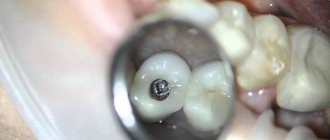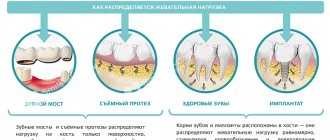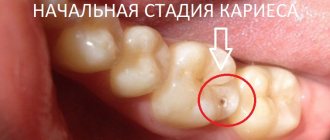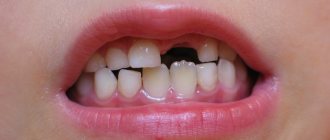Have you already met the tooth fairy, who brings you a coin for a lost baby tooth? Sleepless nights are over, your baby pleases you with twenty temporary teeth and you are starting to think about when to expect permanent ones? Let's try to figure it out when baby teeth fall out
, what you need to remember and what to pay attention to when your child changes
baby teeth
to permanent ones.
How it all happens
First of all, a little anatomy. Baby teeth are formed in the prenatal period, but the formation of permanent teeth begins after the baby is born. Thus, when you rejoice at the first tooth that has erupted, its replacement is already waiting in the wings. The time and order of eruption of permanent teeth, as well as milk teeth, is individual for each child. But temporary teeth fall out in approximately the same order as they appeared. The permanent first molars appear first. There is no milk analogue for these teeth, because in a small child’s jaw there was simply not enough space for them. The baby grows, the gaps in the dentition increase and the first adult teeth appear in the mouth - the so-called “sixes”. After the molars have erupted, it is time to replace the baby teeth with permanent ones. Loss occurs, as a rule, in the same order as appearance.
The procedure and timing of changing baby teeth to permanent ones
When does it make sense to wait for the first permanent teeth to appear? As we said above, the first molars to erupt are the teeth that are not included in the primary set. This happens around the age of six. The next ones to wait for are the front teeth, which displace the milk teeth. Tooth loss in children
It begins with the temporary root gradually resolving, making room for the permanent tooth. The baby tooth becomes loose, falls out, and very soon your child will be able to boast a real, adult set of teeth.
Interesting Facts
Enamel color
The natural color of enamel can be absolutely anything and it is extremely rare that it is snow-white. As a rule, the enamel is slightly yellowish or grayish. In children, teeth may even have a bluish tint, which indicates the presence of a large pulp and its close location to the enamel
About a child's first teeth
Some babies may be born with one or even more teeth, which form in the womb. It also doesn’t matter the age when the baby’s first teeth appear – at three or ten months. The main thing is that, in general, the milk bite is formed completely and correctly.
About the important role of baby teeth
Milk teeth serve primarily as the basis for permanent ones - they literally pave the way for them. If the first teeth grow straight, it is not at all necessary that the subsequent ones will grow as well. However, the opposite situation is also possible, so the formation and growth of all teeth should be monitored under the supervision of the attending physician.
About wisdom teeth
Wisdom teeth may not erupt – this is a completely normal and fairly common occurrence. Whether to remove or leave grown ones depends on their condition: if they only bring discomfort, in the presence of caries or pulpitis it is extremely difficult to cure them, it is quite possible to sacrifice such teeth, since they do not bear any functional load
About oral hygiene
According to statistics, only 57% of women and 46% of men cleanse twice a day. The rest periodically skip such an important procedure, which allows you to effectively cope with plaque and thereby protect the enamel and gums from attack by harmful bacteria.
About using dental floss
According to research, today only 50% of the population flosses daily. Meanwhile, this is an excellent way to prevent many dental diseases: it is the floss that effectively cleans the interdental spaces from food debris and plaque. Today, the only alternative to thread can be an irrigator - a brush cannot cope with such narrow spaces
Tooth loss chart
Here is an approximate order of loss of temporary teeth, which is preceded by the resorption of their roots:
- the roots of the upper and lower central incisors begin to decrease from 4-5 years. As a rule, this process lasts about two years and they fall out by the age of 6-7 years;
- the upper and lower lateral incisors become loose from the age of six and their permanent analogues should be expected at the age of 7-8 years;
- The first molars above and below can be prepared for replacement within three years. The process of root resorption begins at the age of 7 and permanent ones appear by the age of 9-11;
- next in line are the upper and lower canines. The root dissolves starting at the age of eight and children show off new fangs by the age of 9-12;
- The second molars complete the process of tooth replacement. Baby teeth will fall out around the tenth year of life.
Timing of permanent teeth eruption
Permanent teeth in children erupt in the same order as baby teeth:
- central incisors above and below: permanent teeth appear in first-graders - at 6-7 years from below and at 7-8 years from above;
- the lateral incisors on both jaws change to permanent ones at 7-9 years of age;
- permanent first premolars appear by 6-11 years, and second ones should be expected no earlier than 10-12 years;
- at the age of nine to twelve, the upper and lower canines appear;
- The appearance of molars usually begins at the age of six and ends at the age of 21, when the third molars erupt.
Please note: the information above is approximate, and if your baby's teeth are not appearing on schedule, there is no reason to worry. In some children, permanent dentition forms earlier, in others - later. In any case, by the time they reach adulthood, most teenagers can already boast a full set of permanent teeth, and all that remains is to wait for the “eights” - wisdom teeth. However, more and more often, recently, wisdom teeth do not appear at all, as they are rudimentary and practically do not participate in the chewing process.
Early tooth loss
The time of tooth loss depends on the individual characteristics of the child’s body. However, premature tooth loss can be dangerous. The thing is that if a baby tooth is missing for a long time, then the neighboring teeth move, and there is simply no room left for the permanent one, which begins to grow in due course. This situation can cause a violation of the correct bite, distort the dentition and require long-term treatment by an orthodontist.
What causes premature tooth loss in children:
- various injuries;
- periodontal diseases;
- caries;
- infectious diseases suffered by a child in preschool age.
If a baby tooth has fallen out, and its permanent replacement is not expected soon, consult a dentist. In modern dentistry, there are special designs - plates that do not allow neighboring teeth to move and preserve space for a permanent tooth. Such systems do not injure tooth enamel, do not involve grinding of teeth and do not interfere with the baby while talking and eating.
Why do empty spaces remain unoccupied for a long time?
It often happens that a child walks around with a toothless smile for a long time, but the situation still does not change. When examining his oral cavity, the parents do not see even a hint of an imminent full bite. This happens when:
- Retentions. Dental pathology in which a segment of gum tissue is shown very little or not at all. The violation may be complete or partial. In any case, if it occurs, you should consult your dentist. Sometimes the situation can only be corrected through surgery.
- Edentia. The banal absence of a permanent germ. So, for example, a temporary fang falls out, and there is nothing to replace it with. The anomaly can be confirmed using x-ray diagnostics - the images show that the rudiment is missing. Fortunately, congenital adentia is rarely diagnosed in young patients. If it is, only prosthetics will save you.
- Impacts. Difficulties with eruption with this diagnosis are explained by the fact that the crowns of the “neighbors” are too close to each other and do not leave room for the crown, which should be between them. Deviations can also be detected using x-rays.
If there are any problems with the bite, parents should show the baby to the doctor. Moreover, children should have annual checkups at the dentist's office. This simple measure serves as an excellent prevention of serious complications and reduces the likelihood of an unattractive smile in adulthood.
Delay in loss of primary teeth
Your child is finishing school, but some of his baby teeth have not yet been replaced by permanent ones? It is worth making an appointment at a dental clinic. Temporary teeth that remain in their places for too long are a sign that there are disturbances in the functioning of the child’s body.
Late tooth loss can be caused by:
- abnormal location of the permanent tooth germ;
- regular stress;
- malnutrition and lack of vitamins and microelements;
- chronic diseases.
Do you want your child to have straight and healthy permanent teeth? Do not neglect preventive examinations at the dentist twice a year.
What not to do?
The following rules will help you avoid bite problems and the appearance of various defects:
- do not allow your child to loosen his teeth if they are not yet going to fall out and are firmly in place;
- teach your child not to touch a loose tooth with dirty hands (and, of course, he should not pick the hole when the tooth has just fallen out);
- Do not give your child a lot of solid foods during the period of bite changes. This way he can break a baby tooth;
- do not fill the hole after tooth loss with alcohol;
- You shouldn’t make fun of your child’s temporary toothlessness.
What to do if your teeth are uneven
Later or premature loss of baby teeth, individual characteristics of jaw development, trauma and many other factors lead to disruption of the position of the teeth. There is no need to worry too much if the emerging permanent teeth do not form a perfectly even row. Contact your orthodontist. Modern dental technologies make it possible to achieve a perfect smile with the help of braces or aligners. A child's jaw is still in the process of formation. Timely treatment is the key to quick and high-quality results.
When does radiography come to the rescue?
Very rarely, but still situations occur in dental practice when even the doctor doubts which tooth he has to work with - a child’s or a molar. In this case, the capabilities of radiography are used. In the photographs you can see:
- length and structural features of the roots;
- presence/absence of radical primordia;
- the location of the unerupted unit and the direction of growth of its incisal edge.
If you need to find out exactly what the situation is with a change in bite in a child, contact your dentist. He will tell you the number of units that should fall out in the near future, and tell you whether it is worth interfering with this process.
What should parents do?
Losing primary teeth is a completely natural process and most often it is not accompanied by pain or complications. Nevertheless, in order to be sure of the baby’s health, you should follow a few simple rules:
- The teeth should fall out on their own. Do not pull out a tooth that has begun to loosen - you may accidentally damage a root that has not yet completely resolved and it will remain in the gum. You can help a tooth only if it really “hangs by one thread.” It’s even better if the tooth is removed by a pediatric dentist;
- After a tooth falls out, the wound may bleed. Give your baby a sterile gauze swab and ask him to bite down firmly - the bleeding will stop in a few minutes. Try not to feed your child for a couple of hours after losing a tooth. For the same period, you should give up hot, sour and salty foods;
- When changing teeth, it is very important to visit the dentist once every six months for preventive examinations. Your doctor will assess the general condition of your teeth and give recommendations on how to care for your baby and permanent teeth;
- Even though baby teeth are temporary, their condition must be treated very carefully. The health of temporary teeth directly affects the health of permanent teeth.
With each new permanent tooth, your child becomes more mature. Attentive attention to oral hygiene and regular dental checkups can give your child one of the main decorations: a healthy and beautiful smile.
Doctors are our pride
We did the research and found out why they trust us. In reviews
On our website, parents note the highly qualified doctors who have knowledge of several related areas and have extensive experience
working with children
. This allows you to see the clinical picture as a whole and plan treatment correctly.
In 2022, family dentistry "DOMOSTOM" in Domodedovo entered the TOP 100 private children's dental clinics in Russia according to the rating of the expert magazine about dentistry Startsmile with the support of Kommersant Publishing House.
Our clinic’s team of professionals knows how to help your child. Sign up for a consultation with us. Attentive doctors will tell you in detail about the condition of the baby’s oral cavity and answer all questions.











